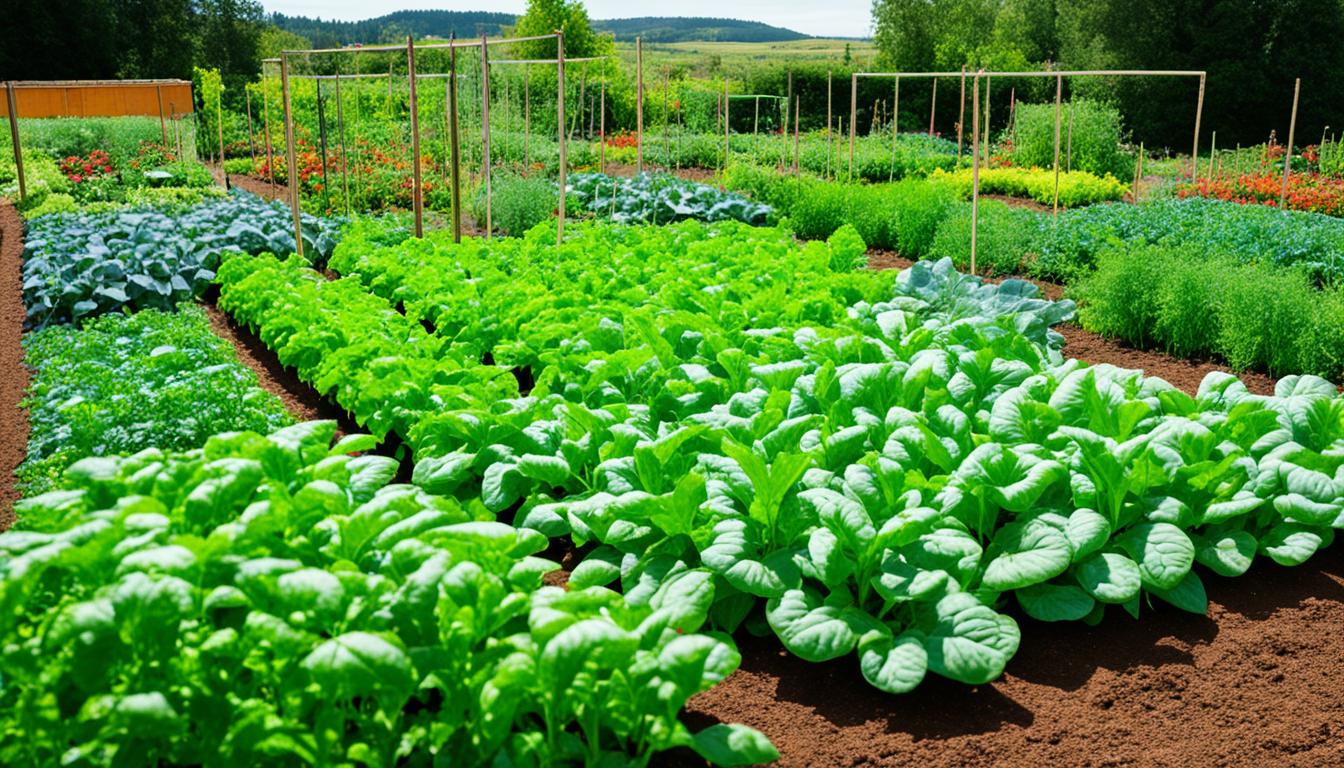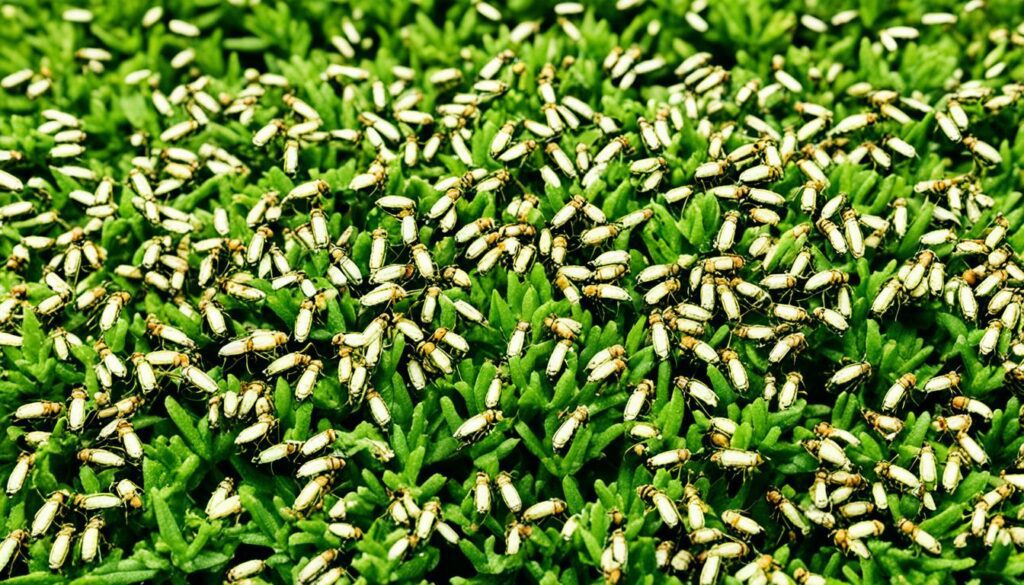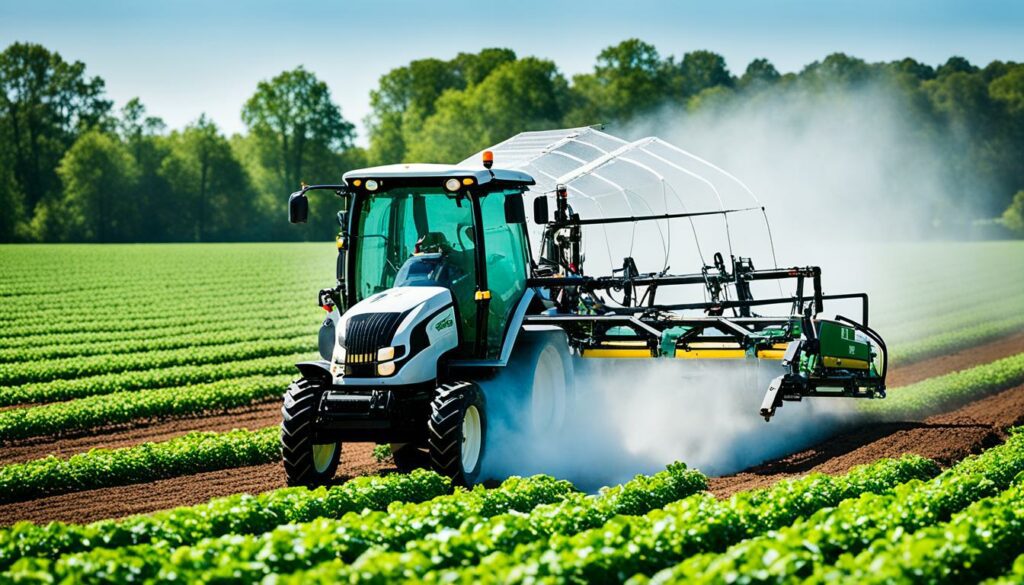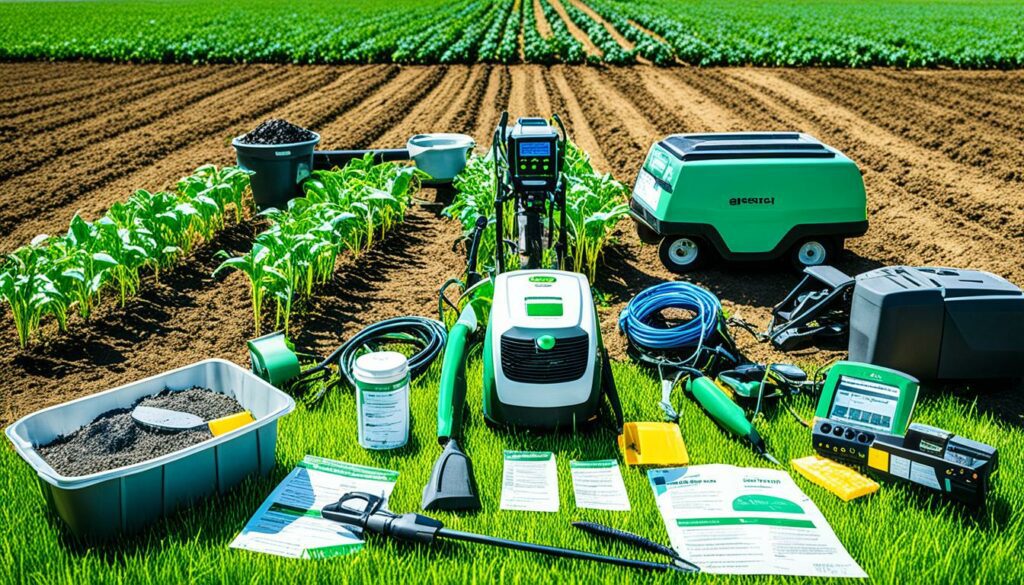Menu

“In Nature, nothing exists alone.” — Rachel Carson
In today’s changing world, farming faces more problems than ever before. Integrated Pest Management (IPM), however, shines as a solution. It’s known as “a sustainable approach to managing pests by combining biological, cultural, physical, and chemical tools in a way that minimises economic, health, and environmental risks,” according to 7 U.S.C. § 136r.
IPM goes beyond just farming. It covers forests, parks, wildlife refuges, and even places where people live and work, like schools and public housing. By using a mix of methods, IPM not only helps save money but also keeps our environment safe.
For this article, we will look at how IPM helps in different areas and its many benefits.
Integrated Pest Management (IPM) is a smart way to handle pests. It uses biology, culture, physics, and chemicals carefully. The goal is to keep our economy, health, and environment safe from pest threats. This method is key for stopping pests in various places, but mostly in farming.
Pests are any living things that cause harm. They might hurt health, the environment, money, or beauty in places like farms, woods, and even homes. IPM deals with these dangers using practices that are made just for them. It focuses on keeping things natural and safe, perfect for the Earth and modern farming.
Managing pests is super important in farming to protect what we grow and its quality. A big group called the Federal Integrated Pest Management Coordinating Committee (FIPMCC) leads the way. It’s made up of groups like the Department of Agriculture and the Environmental Protection Agency. They stress using natural ways and safe methods to fight pests. This keeps farms healthy and the planet green.
IPM is a big help to the environment and our wallets. It stops pests from causing too much damage, meaning less danger for people and nature. The plan is to keep following the National Road Map for Integrated Pest Management. This helps farms stay productive and safe.
Integrated Pest Management (IPM) aims to reduce the harm from pest control on the environment and health. It uses various methods like biological, cultural, physical, and chemical tools. This approach is a sustainable way to manage pests without causing harm.
IPM works towards creating eco-friendly solutions for pest control. It protects our environment and keeps people safe from harsh chemicals. By using strategies like biological control and cultural practices, IPM finds a healthy balance. This balance is key in managing pests without hurting the environment.

IPM also focuses on cutting down pest resistance to pesticides. Pests become immune to the effects of these chemicals over time. To tackle this issue, IPM changes the control methods. It uses a mix of different strategies, including non-chemical ones. This approach delays pest resistance, making pest management methods last longer.
Integrated Pest Management (IPM) is a complete way to handle pests. It deals with pest problems now and in the future. It also helps save money and protects the environment. This makes sure pest control works well over time.
In farming, IPM checks when spending on controlling pests makes sense. It helps by watching pests closely and setting limits on what to spend. This careful approach stops wasting money on unnecessary treatments. It saves a lot of money over time.
IPM focuses on controlling pests without chemicals as much as possible. This not only helps the environment but also keeps the soil healthy.
Less pesticide means safer places to work and live. It matches the aims of farming that cares for the planet.
IPM is very good at stopping pests for the long term. It mixes various approaches to keep pests from getting worse. This keeps pest control methods working well over time.
It responds well to new rules on chemical use in farming. This makes farmers ready for the changing rules on chemical use.
Overall, using IPM brings big benefits. It’s good for saving money and looking after the environment. It also makes sure pest control is effective in the long run.
Integrated Pest Management (IPM) is a proactive way to handle pests, keeping risks low. It looks at each step carefully to make sure pest control methods are safe and efficient. This helps in finding the best ways to stop pests from causing harm.
The first step of IPM is to check for possible pest issues. This means figuring out which pests could harm our plants. Once we know the threat, we can plan how to deal with it in the best way.
Watching pests closely and knowing exactly what they are is next. This helps in choosing the right ways to control them. It involves both stopping pests and using helpful insects to keep the balance.
The heart of IPM is to stop pests before they become a big problem. Methods like changing the environment, rotating crops, or choosing plants that pests don’t like are used. These steps make it harder for pests to grow in number. For instance, growing marigolds can attract good insects that eat the pests.

Using many strategies together makes pest management better and kinder to the environment. IPM’s main focus is on stopping pests first, then keeping an eye on them and using the best, specific ways to control them. This method helps not only with today’s pest problems but also supports keeping pests at bay in the long run. It means using fewer harmful sprays and keeping nature’s balance stable.
This way of pest control is all about understanding the issue, watching pests closely, and preventing them from becoming a big problem. Thanks to guides like the National Road Map for Integrated Pest Management, we can use smart methods. This lets us keep getting better at managing pests.
| IPM Component | Description |
|---|---|
| Problem Assessment | Identifies potential pest threats and evaluates their impact. |
| Monitoring and Identification | Regular observation and correct identification of pests and beneficial organisms. |
| Preventive Measures | Incorporates cultural practices such as crop rotation and planting pest-resistant varieties. |
Cultural integrated pest management helps keep farming sustainable. It uses the best farming methods to keep pests away while being kind to the earth. These methods focus on keeping crops healthy and stopping pests from thriving.
Looking after the soil is key. Good soil makes plants stronger and less prone to pests. Healthy soil also makes it hard for pests to survive, which is good for the environment.
Rearranging what we plant and where can stop pests from getting comfortable. This approach helps crops stay healthy and deters pest damage. It’s a key part of our pest fighting strategy.
Picking smart times to plant can help avoid pests at their worst. This is an important cultural method in pest control. The use of trap plants is also vital. They draw in pests, helping manage their numbers.
Keeping weeds under control is vital for reducing pest homes. This stops pests from causing too much harm. It keeps the fields clean and helps crops grow strong.
Embracing these strategies is crucial for sustainable farming. They help plants stay healthy and resist pests. This is essential for lasting agricultural success.
In Integrated Pest Management (IPM), biological methods are key for eco-friendly and budget-friendly farming. They use the environment’s own checks and balances to fight pests. This means farmers can use fewer harmful chemicals and work towards sustainable farming.
One way of biological control is bringing in beneficial species to control pests. For example, scientists might release natural enemies from other places to control pests. This is called classical control. It’s done in a very planned and careful way. Another method, augmentative control, involves releasing lots of locally grown predators, parasites, or pathogens. This is particularly useful in places like greenhouses or on specific crops.

There’s also fortuitous control. Here, natural predators show up on their own and help keep pests in check.
To ensure a healthy ecosystem, it’s important to protect the natural pest fighters. It starts by not using too many broad-spectrum pesticides. Such pesticides hurt the good bugs along with the bad. For example, some chemicals like synthetic pyrethroids can be dangerous for helpful insects. But, stuff like Bacillus thuringiensis isn’t so bad.
Another technique is conservation control. It helps by giving natural enemies good places to live. Things like better plants and habitats can increase their numbers. This is especially important when they are not active, like during the winter.
More and more, farmers are choosing biological control because customers want less pesticide. Methods like classical, augmentative control, and conservation are key to handling pest issues.
| Biological Control Type | Description | Common Applications |
|---|---|---|
| Classical Biological Control | Introduction of foreign natural enemies to control invasive pests | Publicly funded scientific projects |
| Fortuitous Biological Control | Natural enemies arrive and control exotic pests independently | Natural incidences in varied environments |
| Augmentative Biological Control | Release of mass-reared natural enemies in deficient areas | Greenhouses, nurseries, specific crops |
| Conservation Biological Control | Enhancing habitat and plant diversity for natural enemies | Agricultural fields, gardens, and landscapes |
Integrated pest management uses various steps to deal with pests. It combines different methods to fit needs in farming, landscapes, and cities. This way, it uses nature, culture, and tools to control pests.
It helps farmers work in safer conditions by cutting down chemical use. Natural ways of controlling pests lower water and air pollution. This also keeps the land safe, making the soil better for growing food.
The method prevents pests from getting used to chemicals. This makes sure the pest control ways keep working. By doing things like changing where crops are planted, it stops pests from spreading.
IPM also uses hands-on ways like picking off pests or using traps. These stop pests without using chemicals. Barriers, like fences, protect crops from animals that might eat them.
It also lets nature help by using bugs or animals that eat pests. Good bugs and tiny diseases that attack pests naturally are used. This way, pests are kept in check.
Creating homes for helpful insects, bats, and birds helps keep the balance. Even choosing the right plants or keeping tools clean plays a part. This approach keeps pests away and makes crops better.
IPM is a wise and green way to handle pests. It deals with immediate issues and helps in the long run. This supports farming that takes care of the environment.
Integrated Pest Management (IPM) uses different methods to fight pests. These include mechanical control and physical barriers. These techniques are key because they reduce the need for chemicals, which can harm the environment.

Handpicking is an easy way to remove pests. It means picking them off plants by hand. This can take a lot of time but works well in small areas where chemicals can’t be used.
Traps are also very useful. They catch pests, stopping them from damaging crops. There are many kinds of traps, such as sticky traps for bugs and bigger traps for rodents. This lets us deal with just the pests we want to, without hurting other animals.
Using barriers is like putting up a wall against pests. It stops them from getting to the plants. Barriers can be fences, covers, or nets. They are a helpful way to keep pests away.
IPM combines these methods to keep pests under control without harming nature. Handpicking, trapping, and using barriers are all part of the plan. This way, we manage pests in a way that’s good for the earth.
In Integrated Pest Management (IPM), we use chemical pest control carefully. This is to make sure our environment and health stay safe. The United States uses over a billion pounds of pesticide each year. So, using these pesticides wisely is really important.
When we deal with pests in IPM, we use pesticides very thoughtfully. We aim to target only the pests we need to get rid of. This approach stops us from harming other animals and the environment.
Knowing when to use pesticides is key. Economic thresholds help decide when the cost of damage is too great. This tells us when we must act. Such careful action uses fewer chemicals and keeps pest control sustainable.
There is a scale of pesticide toxicity. Fungicides are the least harmful, and insecticides the worst. Even among insecticides, we have safer options like soaps. And there are more dangerous ones like organophosphates. The key is to choose wisely. We need to pick the right one for the job. This way, we lessen harm to the planet.
IPM is not just about using chemicals. It includes keeping an eye on pests, knowing them well, and using smart farming methods. This helps us use less chemicals. We can still fight pests but in a way that’s good for our planet.
Integrated Pest Management (IPM) uses nature to control pests effectively. It focuses on disrupting insect activities using pheromones and semiochemicals. This stops insects from mating and gathering without using harmful chemicals.

Integrated control, starting in 1959, has heavily relied on semiochemicals. Pheromones, a vital type of semiochemical, influence insect behaviour. They’re natural substances insects use to send messages that we can manipulate to reduce pest numbers.
Pheromone traps are key in monitoring and managing pests. They use synthetic pheromones to attract pests for easy identification. This method avoids harmful chemicals, protecting useful insects in the area.
Places like California benefit greatly from using behavioural control due to high IPM practices. Here, pesticide levels in agriculture and water reduced. By using these approaches, we can make smart pest management decisions that protect the environment.
| Control Method | Description | Benefits |
|---|---|---|
| Pheromone Traps | Uses synthetic pheromones to attract and capture pests | Effective monitoring and reduction of pest populations |
| Semiochemical Disruptors | Emits pheromones that interfere with mating behaviours | Reduces reproduction rates without harming beneficial insects |
To sum up, pheromones and semiochemicals not only control pests but also support eco-friendly farming. They showcase our drive to innovate and protect the environment while handling pest issues.
The ideas of economic injury levels (EIL) and economic thresholds (ET) are key in Integrated Pest Management (IPM). EIL shows the minimum amount of pests that cause economic harm. ET marks the point at which we should start controlling pests to avoid the EIL.
Stern et al. introduced the EIL concept in 1959, and it’s still crucial in IPM. Economic damage is the injury level that justifies control costs. The EIL is the minimum pests needed to cause losses equal to management costs.
The EIL formula is EIL = C/VIDK. This considers management cost (C), crop value (V), injury per pest (I), damage from the injury (D), and a constant (K). Setting EILs requires understanding how pests affect crop yields through research.
The economic threshold (ET) is vital for starting pest control on time. It’s the pest level at which we act to avoid reaching the EIL. Sometimes it’s at 80% of the EIL to allow for pests’ quick growth.
Deciding on ETs involves looking at pest and crop life cycles, growth rates, and control methods. They may be based on experience or calculated from EILs. These calculated ETs can be fixed, descriptive, or dichotomous, fitting different situations.
Knowing how ETs are set and changed is crucial in IPM. And adjustments must reflect the complex ecosystem interactions. For more in-depth details, resources like “Economic Thresholds for Today’s Commodity Values” and “Economic Thresholds for Integrated Pest Management” by Leon G. Higley and Larry P. Pedigo provide thorough information.
IPM is a systematic way to deal with pests that aims for thorough pest control. It’s key to begin by clearly identifying the pests. Then, regular checks and evaluations of their numbers are needed. Finally, various management steps must be reviewed properly.

Getting pest identification right is critical for IPM to work. For example, thinking a plant is sick due to too much water when it’s actually a disease leads to wrong solutions and plant loss. It’s important to know the pest’s life cycle. This helps in picking the best time to apply control methods, often avoiding the need for chemicals.
Consistently keeping an eye on pest numbers is crucial to act swiftly. Take the case of checking traps in places like school cafeterias to stop pests from spreading. When we monitor pests closely, we can figure out at what point to start control measures. This system makes sure we do pest control efficiently and effectively.
Picking the right control method is a big part of IPM. There are various approaches, from letting natural predators handle pests to using traps and fences. What works best depends on the pest and the situation. It is also vital to always check if the plan works. This way, we ensure the job is done right without any bad effects, sticking to IPM’s main goals.
| Statistics | Description |
|---|---|
| Cases of mistaken identity | Mistaking plant damage due to over-watering for fungal infections can lead to unnecessary pesticide sprays and plant death. |
| Correct pest identification | Essential to understand pest life cycles to determine effective action times, sometimes by the time pests are seen. |
| Monitoring | Setting traps and checking regularly, e.g., roaches in school cafeterias, to prevent infestations. |
| Action thresholds | Levels of pests tolerable based on economic, health, or aesthetic factors. |
| Evaluating results | Vital to assess the effectiveness of pest management actions taken, ensuring no unintended side effects. |
Integrated Pest Management (IPM) is great for the environment but not easy. It is important to know its limits and how to deal with the problems it poses. This helps make IPM work well.
Starting IPM can cost a lot, especially for small farms. It means buying tools for checking pests, training workers, and getting needed items. Help is available from places like the Ministry of Agriculture in Malaysia. But it might not cover all costs.
Using IPM needs a lot of knowledge about pests. You have to know a lot about how they act, their place in nature, and how to handle them. This might be hard to learn, so you have to keep studying and working with experts.

Also, keeping an eye on pests and deciding when to act based on what’s best for the money can be tough. IPM is different from using just chemicals. It requires looking closely and studying data so you use as few chemicals as possible. This is a good way to fight pests in the long run. But it shows the need for a lot of learning about pest control.
| Advantages of IPM | Disadvantages of IPM |
|---|---|
| Reduced reliance on chemicals | Initial high setup costs |
| Slower development of resistance | Requires technical expertise |
| Long-term sustainability | Close monitoring needed |
| Maintenance of a balanced ecosystem | Limited effectiveness in severe pest situations |
Despite the hard parts, IPM is a good approach. But we must work on its issues and share knowledge to make it better. This way, everyone involved can do well with IPM and make farming sustainable over time.
Our crop systems are struggling to produce more on less land. This makes it urgent to find eco-friendly ways to control pests. We’ve used too many chemical pesticides, causing problems like pest resistance and harming the environment. Integrated Pest Management (IPM) is a solution that mixes different methods for better results and less impact.
IPM combines several ways to control pests, like using natural enemies of pests or changing farming practices. This approach is growing worldwide, helping keep pests in check without hurting nature. Since the use of chemical sprays started last century, we’ve looked for methods that work better and don’t harm the environment. Rachel Carson drew attention to these issues with her book “Silent Spring,” leading to a wider use of IPM.
IPM is at the forefront of smart pest control by focusing on environmental management. Techniques such as changing crops each season and using plants that don’t attract pests are key. These methods help keep pests away while building a healthy environment for helpful insects. Knowing exactly which pests are around and checking them often is important in IPM. This means acting on pest numbers before they harm crops. Being proactive is crucial for crop protection over time.
IPM is a promise to farm in a way that’s better for the planet. It cuts down on chemical use and mixes different pest control methods. This helps our soils stay fertile and our food supply safe. For those keen to learn more about IPM, there is a detailed study on Integrated Pest Management Models. Let’s keep improving our farming methods so that green pest control becomes the standard.
Integrated Pest Management (IPM) is a smart way to protect crops from pests without heavy chemical use. It brings together many methods to keep fields safe in a natural and safe way. This helps farming be sustainable and protects people and the planet.
IPM is vital in farming as it tackles pests in a way that is good for the economy and the environment. It looks at pests broadly to include anything that harms crops. This means farmers can choose the best way to deal with pests for their situation.
The main goals of IPM are to reduce harm to the environment and our health from pest management. It aims to keep pests from getting too used to control methods. By using various approaches, it lowers how much we rely on any one control method.
Using IPM means spending less on chemicals and more on nature-friendly ways to deal with pests. It also cuts down on pollution. This approach is better for the soil and supports farming in the long run.
IPM works by carefully looking for potential pest problems and finding them early. Then, it uses methods like changing crops and planting times to stop pests before they start.
Cultural IPM methods help by making the plants and their environment less inviting to pests. These include adding nutrients to the soil, changing what crops are grown and when, and managing weeds to remove places pests like to live.
In IPM, biological control means using helpful bugs and plants to naturally keep pests in check. This method helps keep the natural balance, which controls pests without chemicals.
Mechanical and physical IPM methods are hands-on, such as picking off bugs or using nets to keep them away. Farmers might also put up fences to protect crops. These ways fight pests without using harmful chemicals.
Chemicals are used in IPM only when necessary and in a careful way. Only pesticides that target specific pests are chosen. They are a last choice to make sure pest damage is controlled without harming the environment.
To change how insects act, IPM can use special scents to confuse them. This smart method reduces pests without adding more chemicals into the environment.
Economic Injury Levels (EIL) show how many pests are too many for a crop’s health. Economic Thresholds (ET) tell us when it’s time to start controlling pests to stop them from causing too much damage.
Setting up IPM means knowing what pests you are dealing with, watching them to see how many there are, and then picking the best way to control them. This helps manage pests before they become a big problem.
The hard part of IPM is the cost and needing to know a lot about the environment. To do IPM well, you must understand not just the pests but also how nature works. This is crucial for its success.